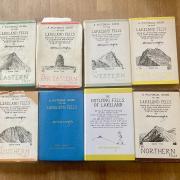Springer spaniels Denzel and Kilo sniff out water leaks across the North West
Meet Denzel. He’s one of the UK’s first water sniffer dogs specifically trained to find leaking water mains, helping to save millions of litres of water every day. Denzel was trained by Luke Jones, an ex-military dog handler, and now the pair work as a team detecting water leaks for United Utilities throughout the North West from Carlisle to Crewe.
Luke who has previously done a tour of Afghanistan explains: ‘Using dogs to search for explosives or drugs is well known, but there are a host of other applications that we are only beginning to explore. Originally, Denzel was trained to detect bed bugs in places such as hotels, universities and Youth Hostels. Two years ago when we saw that the Australian Water Cooperation were trialling dogs to detect leaks we decided to find out more and began a training programme with Denzel alongside my friend Ross Stephenson, also ex-military, with his dog Snipe.’
Snipe, a rescue dog, was the first canine to work in the UK to sniff out leaks, initially in the North West but is now working largely in the Thames Water area with Ross.
Denzel, a five-year-old Springer Spaniel, came to Luke as a puppy and their bond is strong, whether working or off duty. ‘He’s a great pet and is calm in the house but he has an incredible drive and willingness to train and work. A dog’s nose is an amazing tool and he quickly adapted when introduced to a new scent, starting with higher levels of chlorine before moving on to normal levels. He has been trained to detect chlorine in different contexts and environments but he mostly works in rural areas which is safer and more straight forward. We were recruited by United Utilities in 2018 and now work with them for three days a week.’
As rural leaks do not always show on the surface, Denzel‘s nose is a great asset, detecting mains water at incredibly low concentrations as the chlorine scent comes to the surface of the soil. Through being able to smell one-part chlorine in a million parts of water he is able to pinpoint exact leak locations and work alongside other innovations such as satellites. The clever canine indicates a find through standing perfectly still, tail wagging, with his nose pointing down to the ground at the exact location.
Denzel is already proving to be an invaluable asset to the water company and he works alongside another Springer called Kilo. Harnessing what comes naturally – using his nose – Kilo has recently made his first big find. United Utilities calculated that one leak he found, now fixed, has saved 72,000 litres of water a day.
Hannah Wardle, Leakage Manager for United Utilities explains: ‘Tackling leakage is a real priority for us and we’re always looking for new and innovative ways to do the job more effectively. The North West is a notoriously wet region and sorting the leaks from the puddles, especially out in the fields, can be a real challenge and pinpointing the exact place to start digging is more difficult than you might think. We’re really happy with the results we’re getting from the dogs.’
In the battle to beat water leaks, United Utilities has also teamed up with inventors to develop artificial intelligence capable of tracking down leaks across their network of pipes. It may not look like a canine, but FIDO uses rapid machine-learning to ‘listen’ and interpret the unique acoustic data trail left by leaks. Then, a bit like sniffer dogs, it tracks them down to pinpoint the exact location of a leak. While the dogs come into their own in the countryside, FIDO is effective in finding leaks in noisy areas where traditional listening methods are difficult.
Fido Tech Ltd CEO Victoria Edwards says: ‘The reason FIDO is easy to adopt and deploy in field is that it’s simple, rugged and easy to use. You just shake it and wake it and it fits in your back pocket. Once activated, it picks up sounds, vibrations and kinetic data and feeds them back to the growing A1 leak library for real-time analysis, to say where the leaks are, to within a distance of one metre. It can be either used above ground as a listening stick or tethered to a lead and put inside the pipe itself. It learns quickly and can even calculate, with increasing accuracy, how severe the leak is, helping us prioritise. It is really revolutionising or response to leaks.’




























